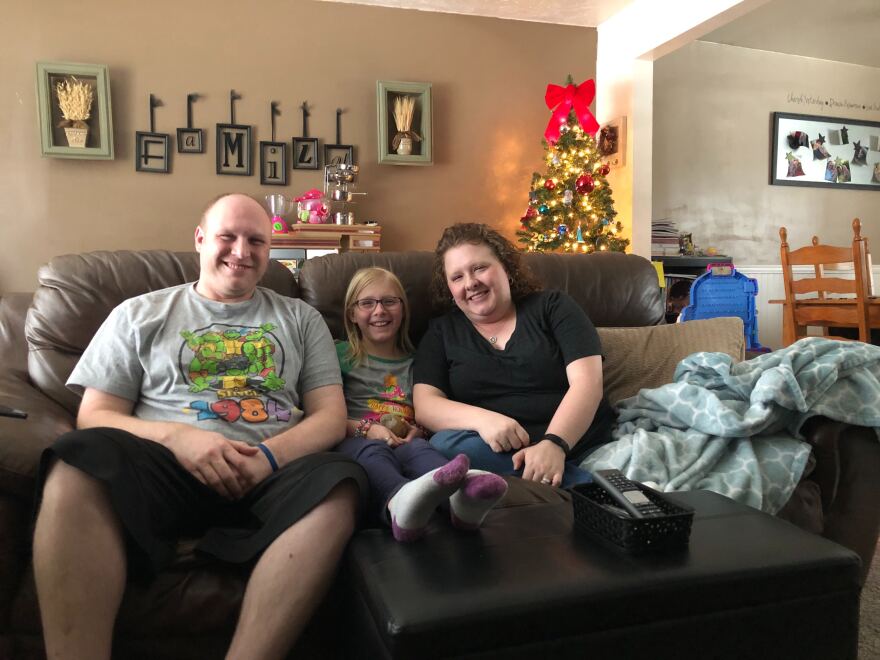Amazon has revolutionized online shopping — scroll, click and your package arrives in just a day or two. Amazon’s products get funnelled through fulfillment centers, where workers quickly sort, pack and ship them.
The company promotes its system as a kind of "magic" - with promotional videos that show smiling people working quickly.
But that speed comes at a cost. For former Salt Lake City warehouse worker Derek Parker, the “magic” meant a shoulder injury that still gives him intense pain 10 months later.

On a recent Saturday afternoon, 34-year-old Parker was sitting on a couch in his West Valley City home across from his wife. Their 9-year-old daughter was playing with her toys on the floor.
Parker started working at the center when it opened last summer to help pay the bills when he was between jobs as a graphic designer.
“I expected some physical work to be involved,” Parker said. “There was definitely a few things that surprised me … As long as you're not on break, they don't want you sitting down anywhere and resting, even if the conveyor lines were stopped.”
Parker sorted merchandise at the Amazon warehouse. He would grab items off a conveyor belt, turn around, put them into their designated spots on a shelving unit behind him, and eventually push the sorted merchandise through the shelving unit to another room, where they would be packed into boxes.
He had 7.5 seconds to move each item to meet production requirements. If he didn’t, he could get a write-up. After three write-ups, Parker said, he could be fired.
His wife, Carrie, said that was putting a lot of stress on their family.
“You don't know if next week if he was going to meet his rates,” she said. “And if he did, then great. We were good for another week. But then the next week — I don't know.”
Parker had two write-ups the day he got injured in February. He said he was under a lot of pressure to work fast to keep his job and support his family.
“And so I was going faster and trying to, you know, put more product through,” Parker said.
And that’s how he strained his rotator cuff: quickly turning to grab the next item. It was bad enough that he was placed on modified duty for more than 2 months.
Parker’s injury was one of 157 that Amazon has reported so far this year at the Salt Lake City fulfillment center. That’s according to statistics from OSHA, the federal agency that oversees workplace safety.
The injury rate in Salt Lake is more than double the average of the warehouse and storage industry in Utah and the nation. In interviews with KUER, three other workers at the Salt Lake City warehouse also said the production quotas, and a focus on speed over safety, led to their injuries.
“The guidelines aren't working, so obviously something needs to be changed,” Parker said.
Amazon declined to be interviewed for this story, but said in a statement that its injury rates are so high because they report injuries more than others in the industry. They said safety is their top priority.
But Parker and other workers said that though that message was everywhere at the warehouse, the reality was that speed always came first.
New Warehouse Comes To West Jordan

State and local governments have encouraged Amazon to build warehouses in Utah. The state gave the company a $5.6 million tax break to open the Salt Lake Fulfillment Center. Amazon got another $1.6 million incentive from West Jordan to build a new warehouse there which is set to open next year.
“It’s going to bring a lot of jobs here,” said West Jordan Mayor Jim Riding. “People that work are going to probably want to buy homes closer by.”
Riding said the city didn’t take working conditions into account when they decided to bring Amazon to the city.
“When you talk about some of the things like injuries and businesses, OSHA is the department that looks into all of those things,” Riding said. “And that’s not something we gauge a business coming into the city on.”
The Utah Labor Commission handles workplace safety in the state. According to spokesman Eric Olsen, the injuries at the Salt Lake City Amazon Fulfillment Center have not been severe enough, like a lost limb or hospitalization, to report to the Commission. Olsen also said it has never investigated the warehouse.
“We’ve had a very limited number of complaints that were filed but they weren’t complaints that warranted investigation,” he said.
Olsen declined to give any more details.
Although Derek Parker’s injury wasn’t bad enough to report to the Labor Commission, he said he’s in severe pain to this day.
“There's still some nights that I don't go to sleep until 2:00, 3:00 in the morning just because it hurts so bad,” Parker said.
Sometimes he misses work at his new job due to lack of sleep, and it’s hard to help around the house.
He said that temporary job has had a lasting impact on his life and on his family.
This story was completed with information from Reveal’s Reporting Networks. revealnews.org/network. For more reporting about injury rates at Amazon fulfillment centers, see Reveal’s Behind The Smile series.




